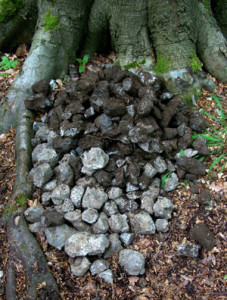My family loves gumbo. When eating out at seafood restaurants, at least one of us will try the gumbo to see how it measures up to previous servings. Making gumbo at home is a task that needs time, patience, but is a wonderful way to mull over life. Philosophers must make wonderful gumbo.
To make gumbo, you need lots of time, a great deal of patience, a good wooden spoon and cast iron skillet plus an empty mind. It works much better to cook the roux over a gas range; electric stoves are too hard to control the temperature. Forget the thought of using a microwave. If you need reading glasses, grab them. You will be on the lookout for tiny black specks of burned flour in the roux. If spotted, it is imperative to throw out the whole thing and start over again. You stand over the stove on low heat, constantly stirring the roux with that wooden spoon and contemplate something pleasant for about an hour. Eventually you will create a delicious dish to enjoy with family and friends. One taste and your legs will no longer ache from standing.
Now I want to introduce you to Black Gumbo made here on the Blackland Prairies in vast quantities around the beginning of the 20th century, at least. Huge cauldrons replaced the cast iron skillets. Wood fires replaced the gas stove. Strong backs were absolutely necessary.
You see, when you dig down into this black, waxy clay around here, you won’t find rocks for a long way down. Our house sits on top of a ridge. When we built, the contractor had 19-foot holes dug for the piers to support the house. Nary a rock or even stone was found.
Today, when roads and parking lots are built, crushed stone is still vital to the roadbed. Railroads must have ballast or good rock base to hold the ties to support the rails. Rock is essential to good construction. Today it is hauled in on trucks, but as late as the 1930s, rocks were made around here by cooking the black, clay soil.
Ask any old-timer out there about the Gumbo Pits and they will proudly tell how gravel was made. Mule teams and log scrappers dug the pits. Men gathered the chunks of clay in wheelbarrows, emptied them into large cauldrons sitting on a wood fire. The heat released the moisture in the chunks. As the clay burned it slowly turned a reddish color. At just the right temperature, the men pulled the glowing coals out from under the pots and emptied them. Scattered across the open space, the chunks cooled to a hard, red stone with no dust.
In January 1916, the Katy Railway announced it would spend 2.5 million dollars to repair 219 miles of track between Greenville and Shreveport as well as the route from Greenville to Mineola. Materials to be used were crushed rock, burnt clay, and gravel. I suspect that burnt clay or gumbo was used when the original tracks were built in the latter part of the 19th century.
In the 1930s the WPA built a large pit near the intersection of Highway 34 and FM 2358 for use in making the roadbed for Highway 34. At that time dynamite was used in place of mules and log scrappers. The dynamite was stored in a wooden building.
As I research the New Deal agencies that attempted to bring employment rates to acceptable levels during the Great Depression, I learn more and more about the labor methods and theories used. It is a fascinating, and sometimes tragic, time in our national history.

